MERCEDES-BENZ E-CLASS CABRIOLET 2010 Repair Manual
Manufacturer: MERCEDES-BENZ, Model Year: 2010, Model line: E-CLASS CABRIOLET, Model: MERCEDES-BENZ E-CLASS CABRIOLET 2010Pages: 333, PDF Size: 7.64 MB
Page 61 of 333
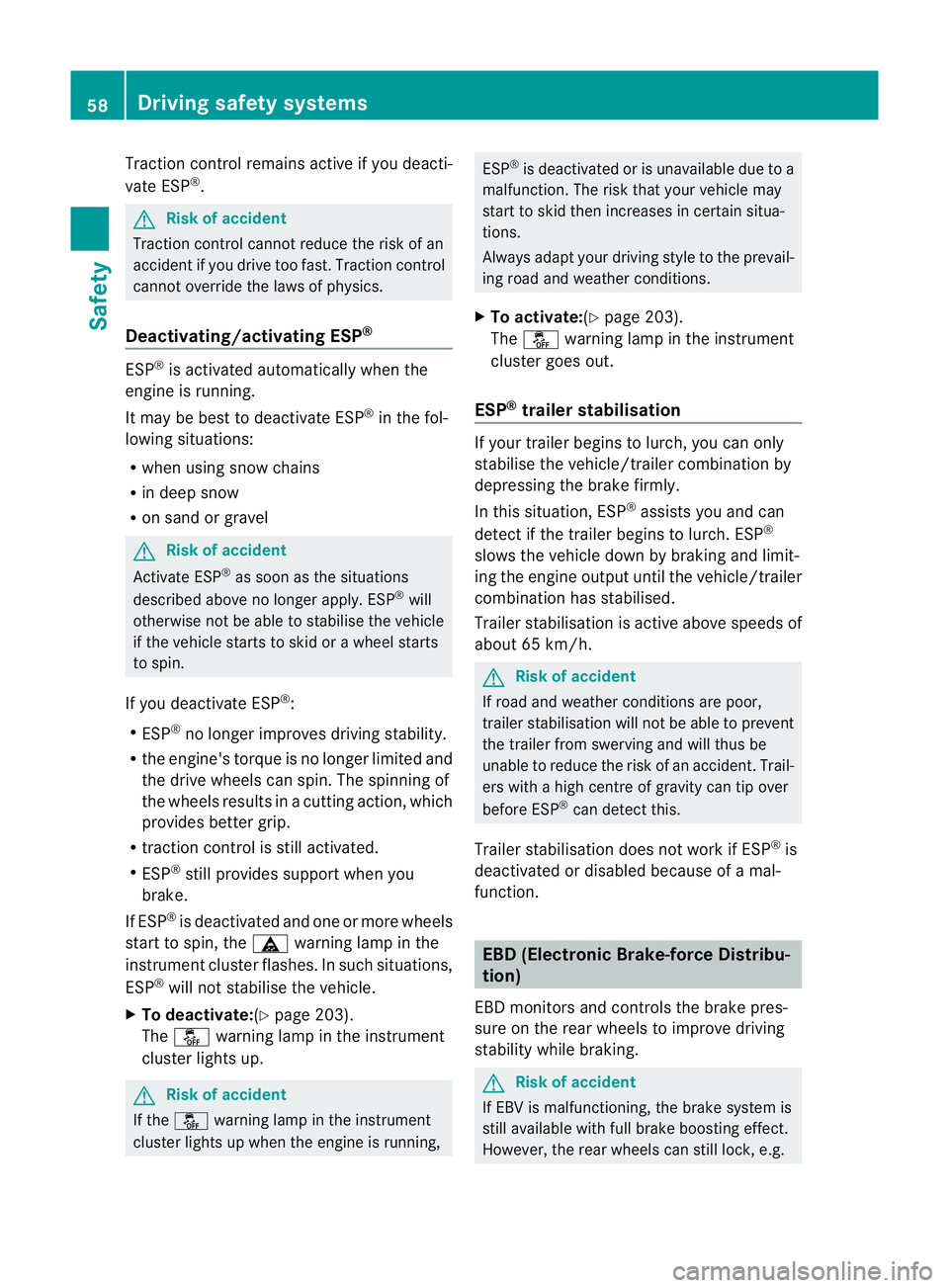
Traction control remains active if you deacti-
vat
eE SP®
. G
Risk of accident
Tractio ncontrol can notreduce the risk of an
accident if you driv etoo fast .Traction con trol
can noto verride th elaws of physics.
Deactivating/activating ESP ®ESP
®
is activated automatically when the
engine is running.
It may be best to deactivate ESP ®
in the fol-
lowing situations:
R when using snow chains
R in deep snow
R on sand or gravel G
Risk of accident
Activate ESP ®
as soon as the situations
described above no longer apply. ESP ®
will
otherwise not be able to stabilis ethe vehicle
if the vehicle star tsto skid or awheel star ts
to spin.
If you deactivate ESP ®
:
R ESP ®
no longer improves driving stability.
R the engine's torque is no longer limited and
the drive wheels can spin. The spinnin gof
the wheels results in acutting action, which
provides better grip.
R traction control is still activated.
R ESP ®
still provides support when you
brake.
If ESP ®
is deactivated and one or more wheels
start to spin, the äwarning lamp in the
instrument cluster flashes .Insuch situations,
ESP ®
will not stabilise the vehicle.
X To deactivate:(Y page 203).
The å warning lamp in the instrument
cluster lights up. G
Risk of accident
If the å warning lamp in the instrument
cluster lights up when the engine is running, ESP
®
is deactivated or is unavailable due to a
malfunc tion. The risk that your vehicle may
star ttos kid then increase sincertain situa-
tions.
Alway sadapt your driving style to the prevail-
ing road and weather conditions.
X To activate:(Y page 203).
The å warning lamp in the instrument
cluster goes out.
ESP ®
trailer stabilisation If your trailer begins to lurch, you can only
stabilise the vehicle/
trailer combination by
depressing the brake firmly.
In this situation, ESP ®
assists you and can
detect if the trailer begins to lurch. ESP ®
slows the vehicle down by brakin gand limit-
ing the engine output until the vehicle/trailer
combination has stabilised.
Traile rstabilisatio nisa ctive above speed sof
about 65 km/h. G
Risk of accident
If road and weather conditions are poor,
trailer stabilisatio nwill not be able to prevent
the trailer from swerving and will thus be
unable to reduce the risk of an accident .Trail-
ers wit hahigh centr eofgravity can tip over
before ESP ®
can detec tthis.
Trailer stabilisation does not work if ESP ®
is
deactivated or disable dbecause of amal-
function. EBD (Electronic Brake-force Distribu-
tion)
EBD monitors and controls the brake pres-
sure on the rear wheels to improve driving
stability while braking. G
Risk of accident
If EBV is malfunctioning, the brake system is
still available with full brake boosting effect.
However, the rear wheels can still lock, e.g. 58
Driv
ings afety systemsSafety
BA 207 ECE ÄJ 2010/1a; 1; 2, en-GB
mkalafa Version: 3.0.2.11 2010-01-26T13:03:22+01:00-Seite 58
Page 62 of 333

under full braking. This coul
dcause you to
lose control of your vehicle and cause an acci-
dent. You shoul dtherefore adapt your driving
styl etot he different handling characteristics. ADAPTIVE BRAKE
ADAPTIV EBRAKE enhances braking safety
and offers increased braking comfort .Inaddi-
tion to the brakin gfunction ,ADAPTIVE BRAKE
also ha sthe HOL Dfunctio n(Ypage 17 2)and
hill start assist (Y page137).For further
inf ormation, se eDriving tip s(Ypage 154). PRE-SAFE
®
Brake (vehicles with DIS-
TRON IC PLUS)
PRE-SAFE ®
Brake can hel pyou to minimise
the ris kofaf rontal col lisionwithavehicle
ahead or reduce the effects of such acolli-
sion.
This function will issu eawarning at spe edsof
around 30 km/h or more if:
R for aperiod of sever alseconds, the dis-
tance to the vehicl einfront is to oshort for
the speed at which you ar etrave lling. The
· distance warning lamp in the instru-
ment cluster lights up.
R you are approaching the vehicle in front too
rapidly .Anintermittent warning tone
so unds and the ·distance warning
lamp lights up in the instrument cluster.
Due to the nature of the system, particularly
complicated driving conditions may caus ethe
system to displa yanunneces sary warning. G
Ris
kofa ccident
Pay particula rattention to the traffic condi-
tions if the ·distance warning lam pinthe
instrument clu ster lights up or an intermittent
warning tone sounds. If necessary, brak eor
manoeuvre to avo idan obstacle. If the driver and passengers have fastened
thei
rseat belts, PRE-SAFE ®
Brak ecan also
can also perform the following at speeds of
above approximately 30 km/h:
R brake the vehicle automatically from a
spee dofuptoa pproximately 20 0km/h
R trigge rpreventative passenge rprote ction
measures (PRE-SAFE ®
) G
Risk of accident
PRE-SAFE ®
Brak eiso nly an aid to assist you
whe ndriving. Yo uare responsible for main-
taining asafe distanc efrom other vehicles,
th ev ehicle' sspeed and for braking in good
time. Alway spay attention to the traffic con-
ditions. Otherwise, you may recognise dan-
gers too late, cause an acciden tand injure
yoursel fand others.
With the hel pofthe radar sensor system,
PRE-SAFE ®
Brak ecan detect obstacles that
are in fron tofyour vehicle for an extended
period of time. If you approach an obstacle
and PRE- SAFE®
Brake detects arisk of acol-
lision, the system will initially aler tyou both
visually and acoustically .Ify ou do not brake
or steer ,the vehicle will at first automatically
brake slightly. In the even tofanincreased
risk of acollision ,PRE-SAFE ®
is activated
(Y page 39). If the risk of collision remains
and you do not brake, take evasive action or
accelerat esignificantly, the vehicle may per-
form automatic emergency braking. G
Risk of accident
Only clearl ydetected obstacles will trigger a
warning and initiat ebraking assistance by
PRE-SAFE ®
Brake.
In particular, th edetection of obstacles can
be impaired if there is:
R dirt on the sensor sorthe sensor sare cov-
ered
R snow or heavy rain Dri
ving sa fety systems
59Safety
BA 207 ECE ÄJ 2010/1a; 1; 2, en-GB
mkalafa Version: 3.0.2.11 2010-01-26T13:03:22+01:00 -Seite 59 Z
Page 63 of 333
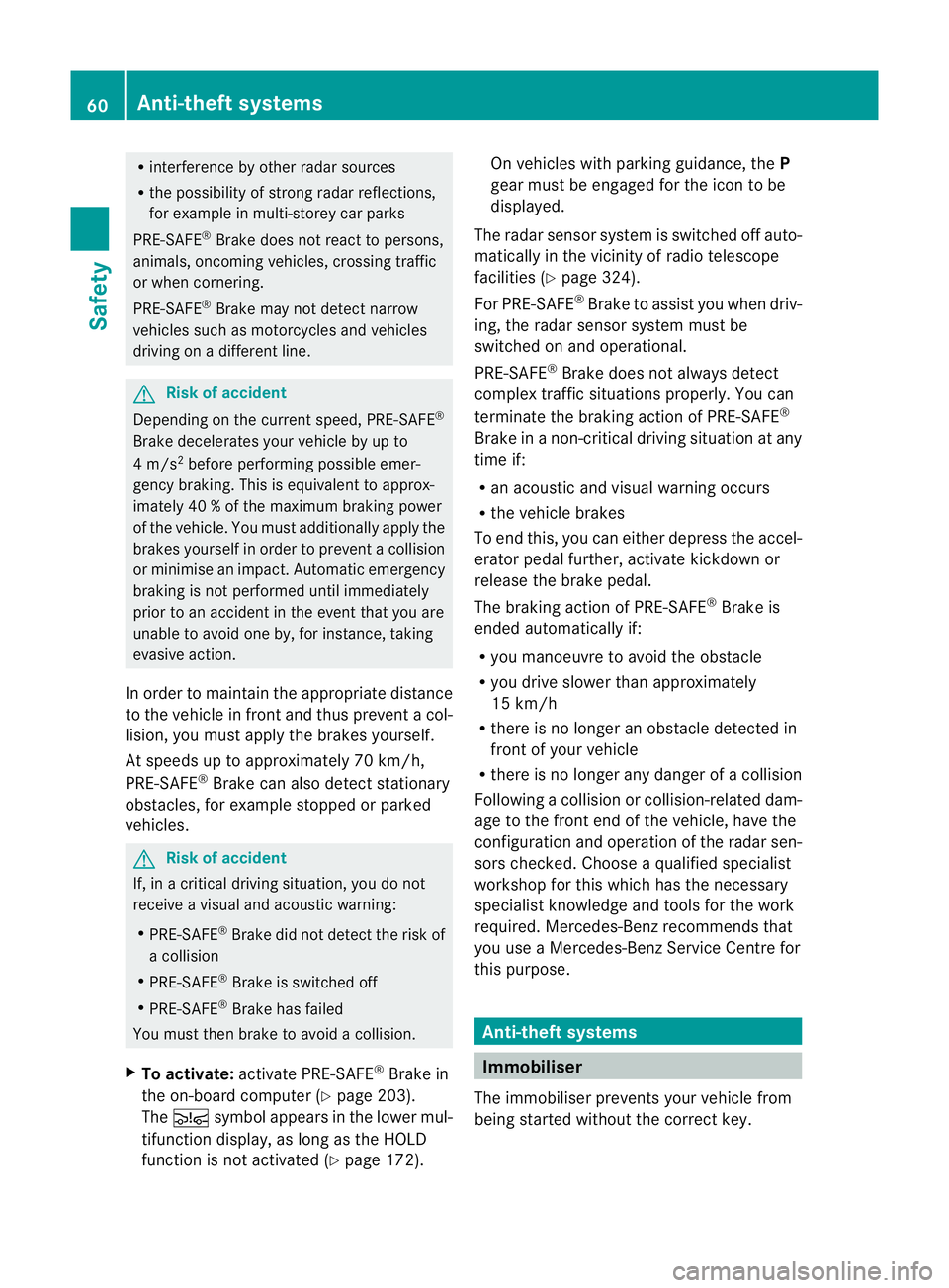
R
interference by other radar sources
R the possibility of strong radar reflections,
for example in multi-storey car parks
PRE-SAFE ®
Brak edoes not react to persons,
animals ,oncoming vehicles, crossing traffic
or whe ncornering.
PRE-SAFE ®
Brak emay not detect narrow
vehicles such as motorcycles and vehicles
drivin gona different line. G
Ri
sk of accident
Dependin gonthe cur rent speed, PRE-SAFE ®
Brak edecelerat es your ve hicle by up to
4m /s2
befo reperformin gpossible emer-
genc ybraking .This is equivalen ttoapprox-
imately 40 %ofthe maximum brakin gpower
of the vehicle. You must additionally apply the
brakes yourself in order to prevent acollision
or minimise an impact. Automatic emergency
brakin gisnot performed until immediately
prior to an accident in the even tthat you are
unable to avoid one by, for instance, taking
evasive action.
In order to maintain the appropriate distance
to the vehicle in front and thus prevent acol-
lision, you must apply the brakes yourself.
At speeds up to approximately 70 km /h,
PRE- SAFE ®
Br ake can also detect stationary
obstacles ,for example stopped or parked
vehicles. G
Risk of accident
If ,inac ritical driving situation, yo udonot
receive avisual and acoustic warning:
R PRE-SAFE ®
Brak edid not detect the risk of
ac ollision
R PRE- SAFE ®
Br ake is switched off
R PRE-SAFE ®
Brake has failed
You must then brake to avoid acollision.
X To activate: activate PRE-SAFE®
Br ake in
the on-board computer (Y page 203).
The Ä symbol appears in the lower mul-
tifunction display ,aslong as the HOLD
func tion is not activated (Y page 172).On vehicles with parkin
gguidance, the P
gear must be engage dfor the icon to be
displayed.
The radar sensor system is switched off auto-
matically in the vicinit yofradio telescope
facilities (Y page 324).
For PRE-SAFE ®
Brake to assis tyou when driv-
ing, the radar sensor system must be
switched on and operational.
PRE- SAFE ®
Br ake does not always detect
complex traffic situations properly. You can
terminate the braking action of PRE-SAFE ®
Brake in anon-critical drivin gsituation at any
time if:
R an acoustic and visual warnin goccurs
R the vehicle brakes
To end this, you can either depress the accel-
erato rpedal further, activate kickdown or
release the brak epedal.
The braking action of PRE- SAFE®
Br ake is
ended automatically if:
R you manoeuvre to avoid the obstacle
R you drive slowe rthan approximately
15 km /h
R there is no longe ranobstacle detected in
front of your vehicle
R there is no longer any danger of acollision
Following acollision or collision-related dam-
age to the front end of the vehicle, have the
con figuration and operation of the radar sen-
sors chec ked. Choose aqualified specialist
worksho pfor this which has the necessary
specialist knowledge and tools for the work
required .Mercedes-Benz recommends that
you use aMercedes-Benz Servic eCentr efor
this purpose. Anti-theft systems
Immobiliser
The immobiliser prevent syour vehicle from
being star tedw ithout the correc tkey. 60
Anti-thef
tsystemsSafety
BA 207 ECE ÄJ 2010/1a; 1; 2, en-GB
mkalafa Version: 3.0.2.11
2010-01-26T13:03:22+01:00
-Seite 60
Page 64 of 333
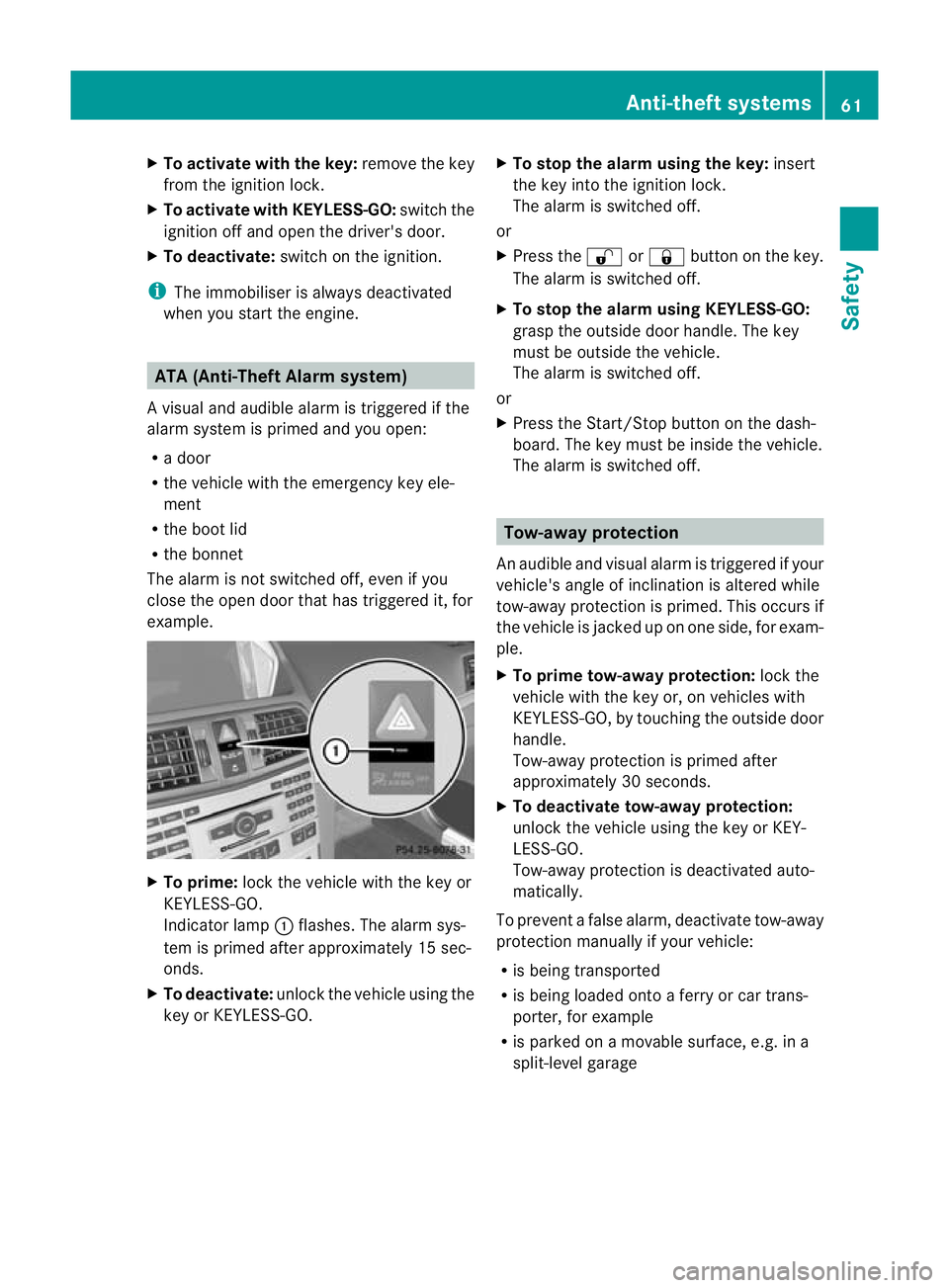
X
To activate with the key: remove the key
from the ignition lock.
X To activate with KEYLESS-GO: switch the
ignition off and open the driver's door.
X To deactivate: switch on the ignition.
i The immo biliserisa lway sdeactivated
when yo ustart the engine. ATA (Anti-Theft Alarm system)
Av isual and audible alarm is triggered if the
alarm system is prime dand you ope n:
R ad oor
R the vehicle with the emergency key ele-
ment
R the boot lid
R the bonnet
The alar misnot switched off ,even if you
close th eopen door that has triggere dit, for
example. X
To prime: lock the vehicle with the key or
KEYLESS-GO.
Indicator lamp :flashes. The alarm sys-
tem is primed after approximately 15 sec-
onds.
X To deactivate: unlock the vehicle using the
key or KEYL ESS-GO. X
To stop th ealarm using the key: insert
the key into the ignition lock.
The alarm is switched off.
or
X Press the %or& button on the key.
The alarm is switched off.
X To stop the alarm using KEYLESS-GO:
grasp the outside door handle. The key
must be outside the vehicle.
The alarm is switched off.
or
X Press the Star t/Stop butto nonthe dash-
board. The key must be insid ethe vehicle.
The alar misswitched off. Tow-away protection
An audible and visual alarm is triggered if your
vehicle's angle of inclination is altered while
tow-away protection is primed. This occurs if
the vehicle is jacked up on one side, for exam-
ple.
X To prim etow-away protection: lock the
vehicle with the key or, on vehicles with
KEYL ESS-GO ,bytouching the outside door
handle.
Tow-away protection is primed after
approximately 30 seconds.
X To deactivate tow-awa yprotection:
unlock the vehicle using the key or KEY-
LESS-GO.
Tow-away protection is deactivate dauto-
matically.
To prevent afalse alarm, deactivate tow-away
protection manually if your vehicle:
R is being transported
R is being loaded onto aferr yorc ar trans-
porter, for example
R is parked on amovable surface, e.g. in a
split-leve lgarage Anti-theft systems
61Safety
BA 207 ECE ÄJ 2010/1a; 1; 2, en-GB
mkalafa Version:3.0.2.11
2010-01-26T13:03:22+01:00
-Seite 61 Z
Page 65 of 333
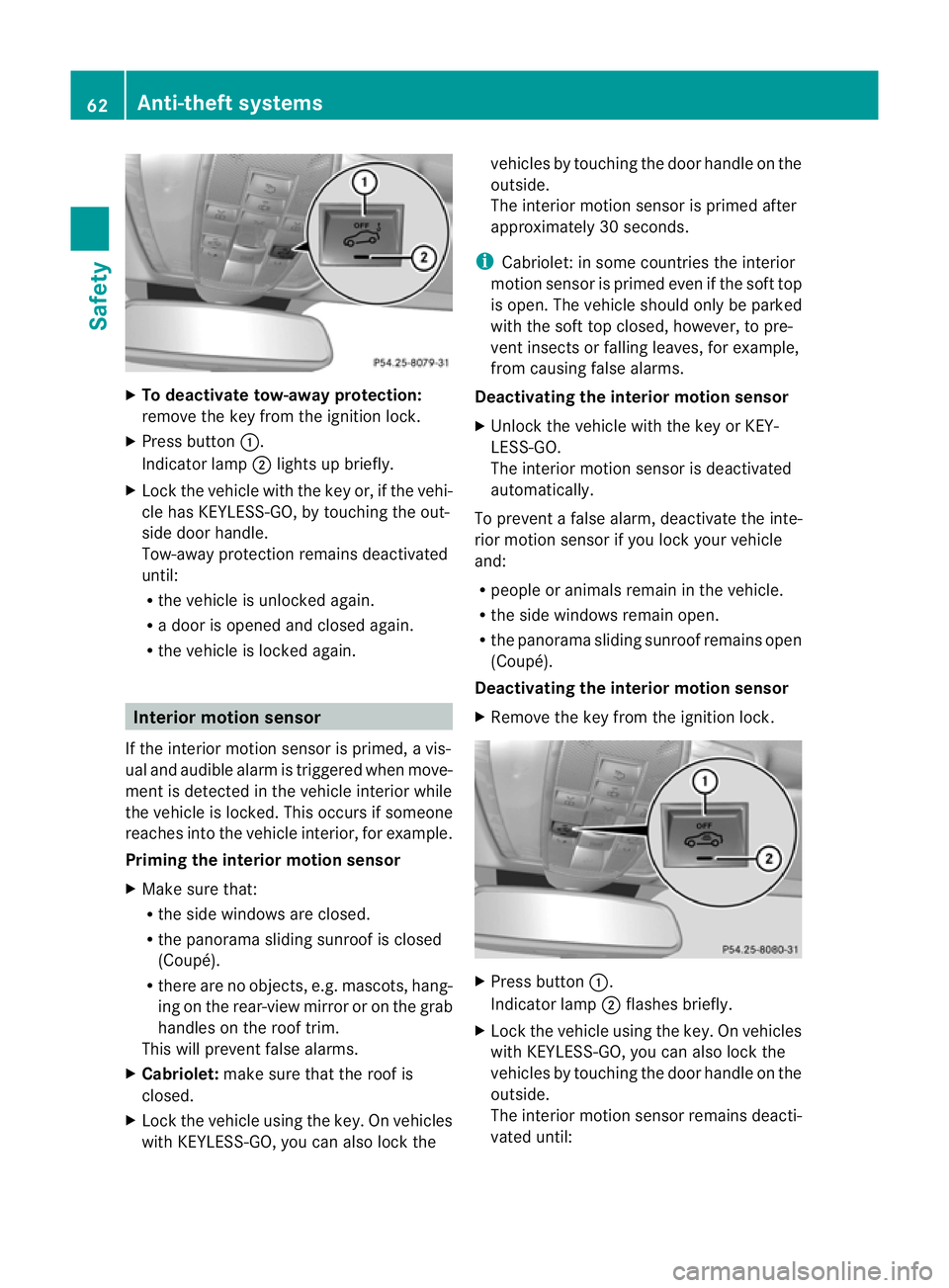
X
To deactivate tow-away protection:
remove the key from the ignition lock.
X Press button :.
Indicato rlamp ;lights up briefly.
X Loc kthe vehicle with the key or, if the vehi-
cle has KEYL ESS-GO,bytouching the out-
side door handle.
Tow-away protection remains deactivated
until:
R the vehicle is unlocked again.
R ad oor is opened and closed again.
R the vehicle is locked again. Interior motion sensor
If the interior motion sensor is primed, avis-
ual and audible alarm is triggered when move-
ment is detected in the vehicle interior while
the vehicle is locked. This occur sifsomeone
reaches int othe vehicle interior, for example.
Priming th einterior motion sensor
X Make sure that:
R
the side windows are closed.
R the panorama sliding sunroof is closed
(Coupé).
R there are no objects, e.g. mascots, hang-
ing on the rear-view mirror or on the grab
handles on the roof trim.
This will prevent false alarms.
X Cabriolet: makesure that the roof is
closed.
X Lock the vehicle using the key. On vehicles
with KEYLESS-GO, you can also lock the vehicles by touching the door handle on the
outside.
The interior motion senso
risp rime dafter
approximately 30 seconds.
i Cabrio let: in some countries the interior
motion sensor is primed even if the soft top
is open. The vehicle should only be parked
with the soft top closed, however, to pre-
vent insects or falling leaves ,for example,
from causing false alarms.
Deactivating th einterior motion sensor
X Unlock the vehicle with the key or KEY-
LE SS -GO.
The interio rmotion sensor is deactivated
automatically.
To prevent afalse alarm, deactivate the inte-
rior motion senso rifyou lock your vehicle
and:
R people or animals remain in the vehicle.
R the side window sremai nopen.
R the panorama sliding sunroof remains open
(Coupé).
Deactivating the interio rmotion sensor
X Remove the key from the ignition lock. X
Press button :.
Indicator lamp ;flashes briefly.
X Lock the vehicle using the key. On vehicles
with KEYL ESS-GO,you can also lock the
vehicles by touching the door handle on the
outside.
The interior motion sensor remains deacti-
vated until: 62
Anti-thef
tsystemsSafety
BA 207 ECE ÄJ 2010/1a; 1; 2, en-GB
mkalafa Version: 3.0.2.11 2010-01-26T13:03:22+01:00 -Seite 62
Page 66 of 333

R
the vehicl eisunlocke dagain.
R ad ooriso peneda nd close dagain.
R the vehicl eislocked again. Anti-thef
tsystems
63Safety
BA 207ECE ÄJ 2010/1a ;1;2,en-GB
mkalafa Version: 3.0.2.11 2010-01-26T13:03:22+01:00-Seite 63 Z
Page 67 of 333

64 BA 20
7ECE ÄJ 2010/1a; 1; 2, en-GB
mkalafa Version:3.0.2.11
2010-01-26T13:03:22+01:0
0-Seite 64
Page 68 of 333
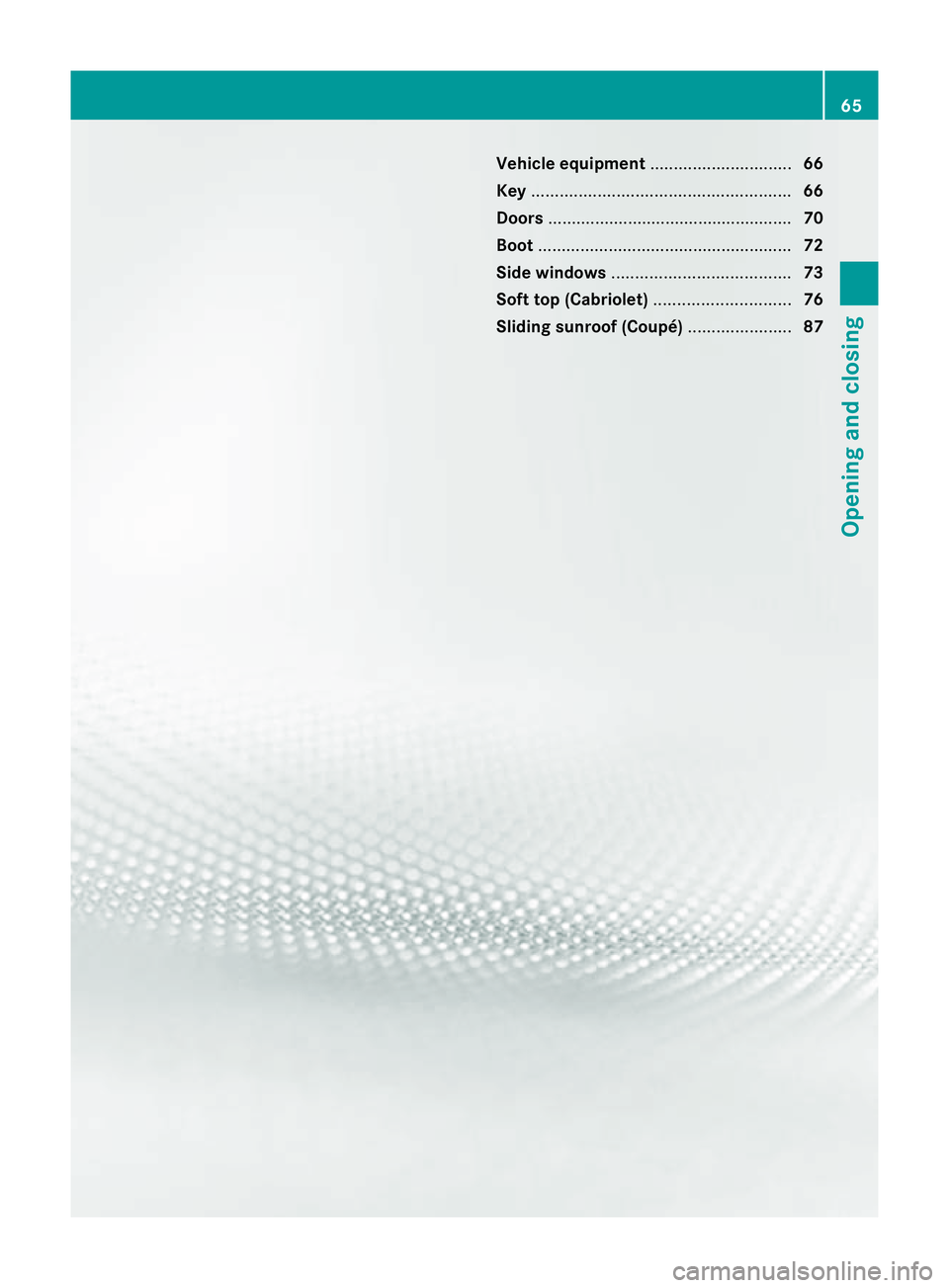
Vehicl
eequipment .............................. 66
Key ....................................................... 66
Doors .................................................... 70
Boot ...................................................... 72
Side windows ...................................... 73
Soft top (Cabriolet) .............................76
Sliding sunroof (Coupé) ......................87 65Opening and closing
BA 20
7ECE ÄJ 2010/1a; 1; 2, en-GB
mkalafa Version:3.0.2.11
2010-01-26T13:03:22+01:0
0-Seite 65
Page 69 of 333
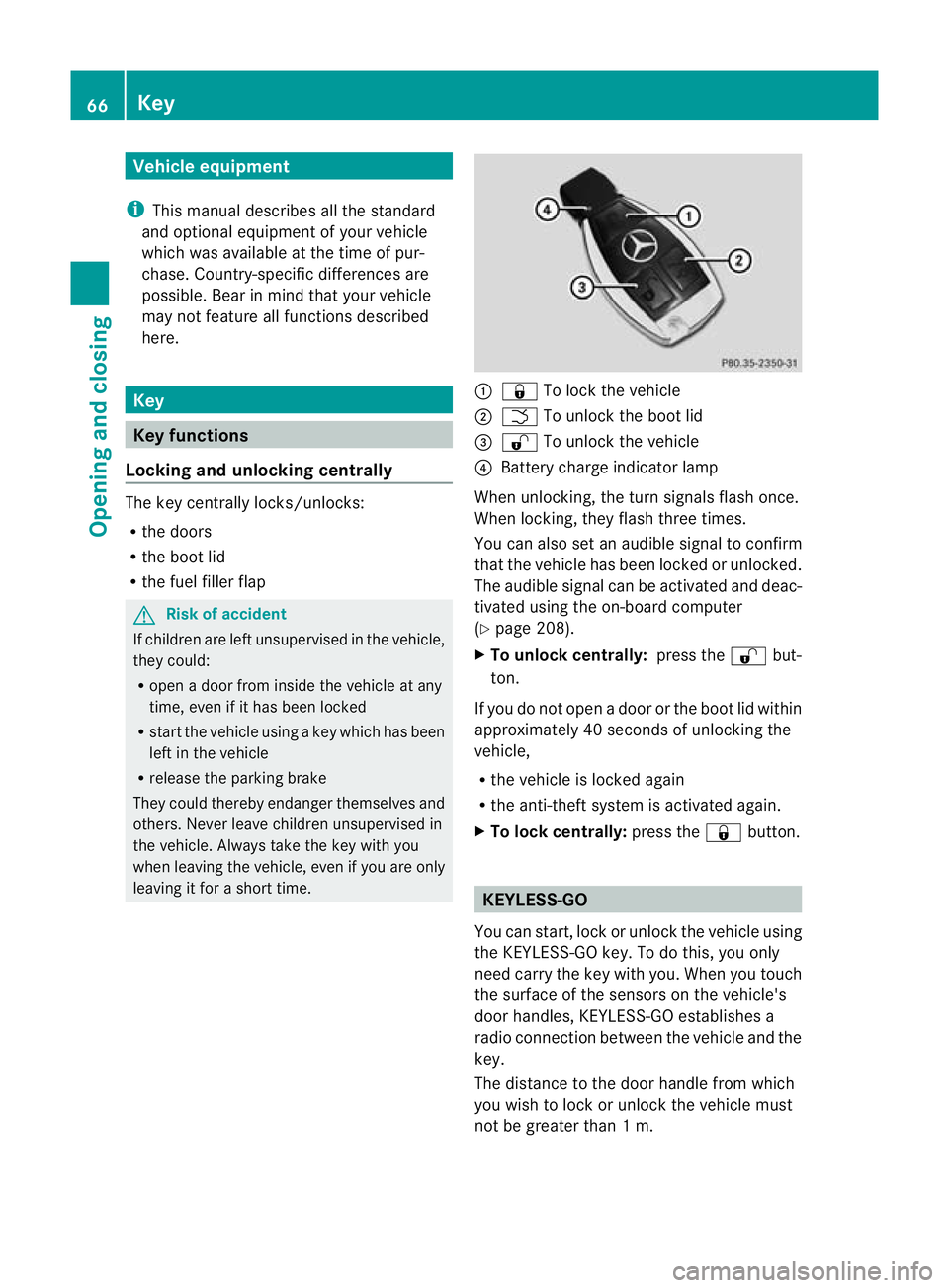
Vehicl
eequipment
i Thismanua ldesc ribe sallthe standard
and optional equipment of your vehicle
which wa savailable at th etime of pur-
chase. Countr y-specif ic differences are
possible. Bear in mind tha tyour vehicle
ma ynot featur eall function sdescribed
here. Key
Key functions
Locking and unlocking centr ally The key centrally locks/unlocks:
R
the doors
R the boot lid
R the fuel filler flap G
Risk of accident
If children are left unsupervised in the vehicle,
they could:
R open adoor from inside the vehicle at any
time, even if it has been locked
R star tthe vehicle usin gakey which has been
left in the vehicle
R release the parking brake
They could thereby endanger themselves and
others. Never leave children unsupervised in
the vehicle. Alway stake the key with you
when leaving the vehicle, even if you are only
leaving it for ashort time. :
& To lock the vehicle
; F To unloc kthe boot lid
= % To unlock the vehicle
? Battery charge indicator lamp
When unlocking ,the tur nsignals flash once.
When locking, they flash three times.
You can also set an audible signal to confirm
that the vehicle has been locked or unlocked.
The audible signal can be activated and deac-
tivated using the on-board computer
(Y page 208).
X To unlock centrally: press the%but-
ton.
If you do not open adoor or the boot lid within
approximately 40 second sofunlocking the
vehicle,
R the vehicl eislocke dagain
R the anti-thef tsystem is activated again.
X To lock centrally: press the&button. KEYLESS-GO
You can start, lock or unlock the vehicle using
the KEYLESS-GO key. To do this ,you only
need carry the key with you. When you touch
the surface of the sensor sonthe vehicle's
door handles, KEYL ESS-GO establishes a
radio connection between the vehicle and the
key.
Th ed istance to the door handle from which
you wish to lock or unlock the vehicle must
not be greater than 1m.66
KeyOpening and closing
BA 20
7ECE ÄJ 2010 /1a; 1; 2, en-GB
mkalafa Version: 3.0.2.11 2010-01-26T13:03:22+01:00 -Seite 66
Page 70 of 333
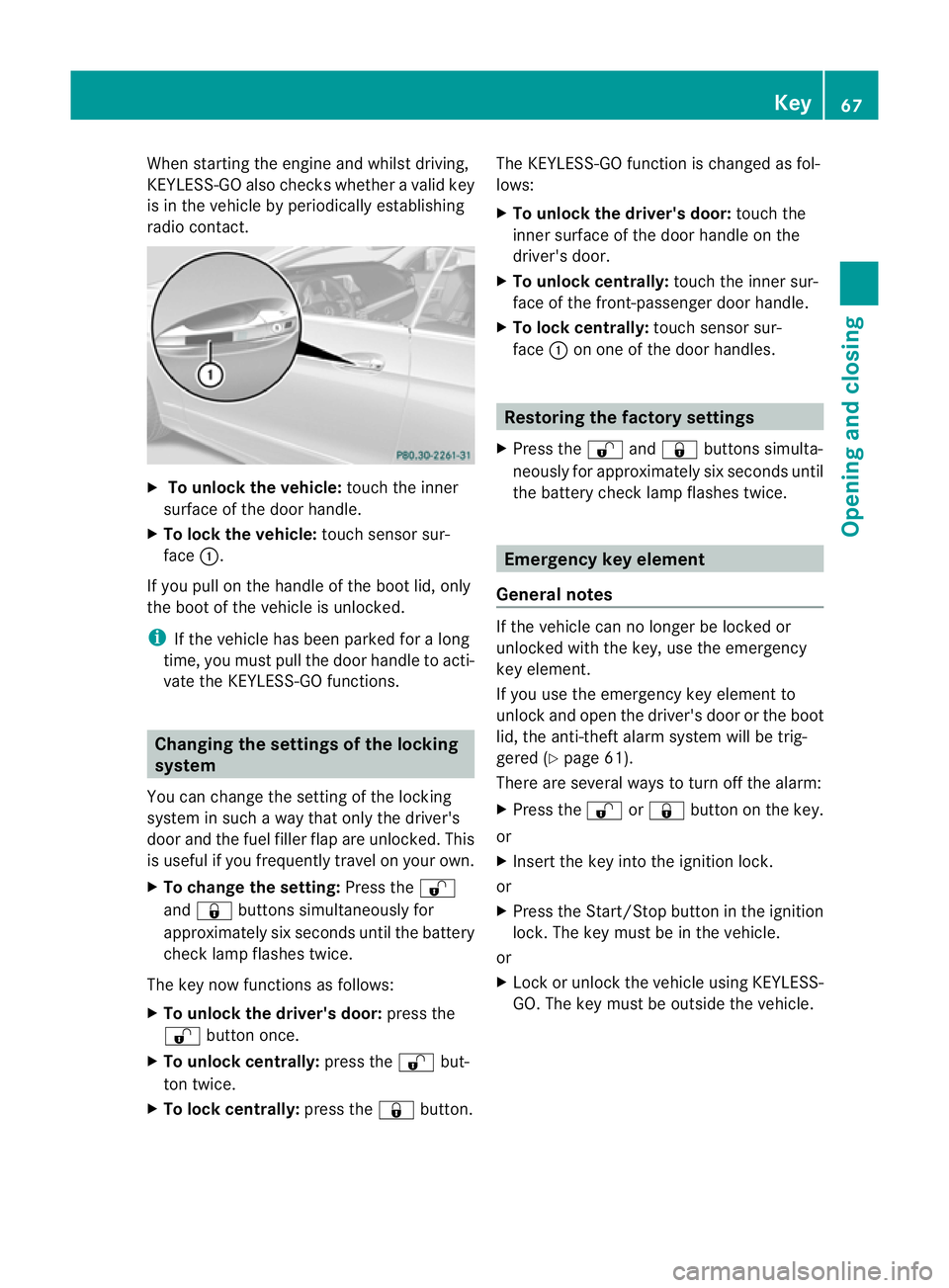
When star
ting the engine and whilst driving,
KEYLESS-GO also checks whether avalid key
is in the vehicle by periodicall yestablishing
radio con tact. X
To unlock the vehicle: touch the inner
surface of the door handle.
X To lock the vehicle: touch sensorsur-
face :.
If you pull on the handle of the boot lid, only
the boot of the vehicle is unlocked.
i If the vehicle has been parked for along
time, you must pull the door handl etoacti-
vate the KEYLESS-GO functions. Changing the setting
softhe locking
system
Yo uc an change the setting of the locking
system in such away that only the driver's
door and the fuel filler flap are unlocked. This
is useful if you frequently travel on your own.
X To change the setting: Press the%
and & buttons simultaneously for
approximately six seconds until the battery
check lamp flashes twice.
The key now functions as follows:
X To unlock the driver's door: press the
% button once.
X To unlock centrally: press the%but-
ton twice.
X To lock centrally: press the&button. The KEYLESS-GO function is changed as fol-
lows:
X
To unlock the driver's door: touch the
inner surface of the door handle on the
driver' sdoor.
X To unlock centrally: touchthe inner sur-
face of the front-passenger door handle.
X To lock centrally: touchsensor sur-
face :on one of the door handles. Restoring the factor
ysettings
X Press the %and& buttons simulta-
neously for approximately six seconds until
the battery check lamp flashes twice. Emergency key element
General notes If the vehicle can no longer be locked or
unlocked with the key, use the emergency
key element.
If you use the emergency key element to
unlock and open the driver's door or the boot
lid, the anti-theft alarm system will be trig-
gered (Y
page 61).
There are several ways to turn off the alarm:
X Press the %or& button on the key.
or
X Insert the key into the ignition lock.
or
X Press the Star t/Stop butto ninthe ignition
lock .The key must be in the vehicle.
or
X Loc koru nlock the vehicl eusing KEYL ESS-
GO. The key must be outside the vehicle. Key
67Opening and closing
BA 207 ECE ÄJ 2010/1a; 1; 2, en-GB
mkalafa Version:3.0.2.11
2010-01-26T13:03:22+01:00
-Seite 67 Z